Karoo - Cora Gooseberry 1770s - 1852
Cora Gooseberry, also known by her Aboriginal name recorded as Karoo, Carra, Caroo, Car-roo or Ba-ran-gan was an acknowledged Aboriginal leader of coastal Sydney, daughter of Moorooboora (Maroubra) and a wife of Bungaree, both prominent indigenous leaders. Cora was a holder of cultural knowledge and like Bungaree, a leader and well-known identity in the wider Sydney community during the early years of the Colony.
Image: '[Cora] Gooseberry, Widow of King Bungaree' c1836. Attributed to W.H. Fernyhough. SLNSW FL1077996.
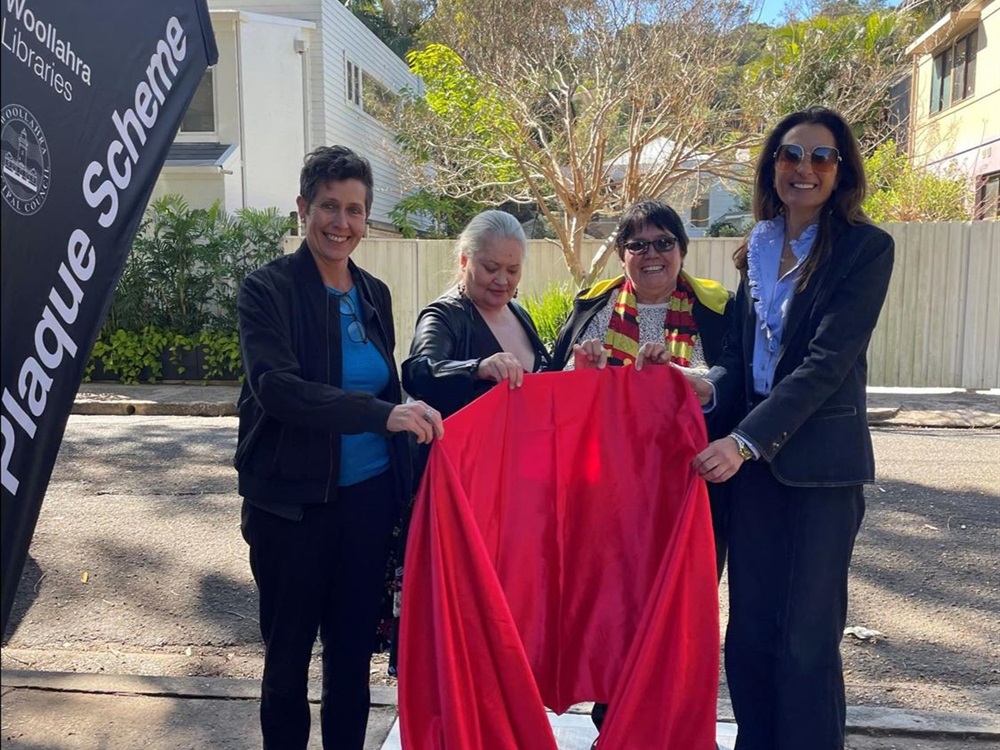
Plaque unveiling for Cora Gooseberry (Karoo) on Cove Street near Camp Cove Reserve, Camp Cove on 11 August 2023. L-R Corinna Pierce (nominator); Melissa Jackson, Indigenous Engagement Librarian State Library of NSW (Guest Speaker); Aunty Maxine Ryan (La Perouse Local Aboriginal Land Council); Woollahra Mayor Cr Susan Wynne.
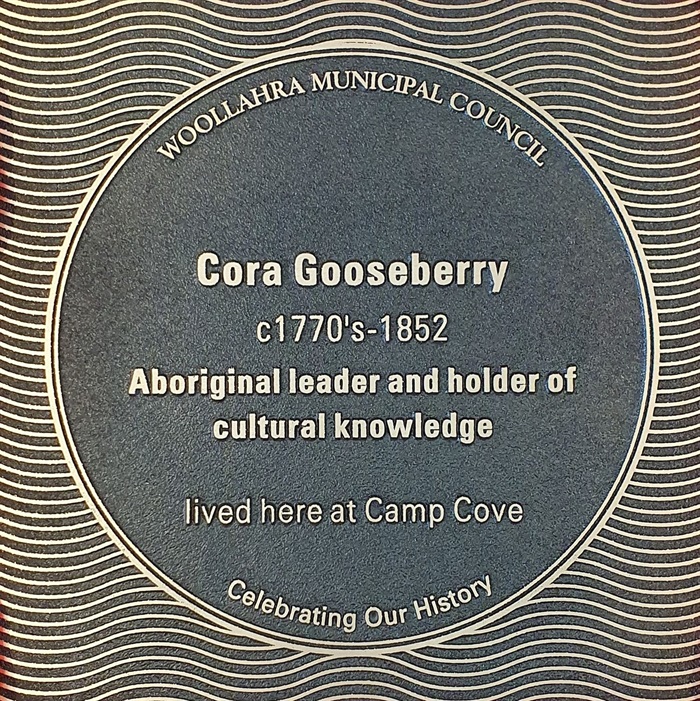
A plaque to commemorate the life and legacy of Cora Gooseberry (Karoo) was unveiled at Cove Street, near Camp Cove Reserve, on 11 August 2023, where she lived during the 1840s.
Unveiling Gallery
Karoo - Cora Gooseberry
c1770s - 30 July 1852
Aboriginal Elder and holder of cultural knowledge
Cora Gooseberry, also known by her Aboriginal name recorded as Karoo, Carra, Caroo, Car-roo or Ba-ran-gan (Smith, ADB, 2005), was an acknowledged Aboriginal leader of coastal Sydney, daughter of Moorooboora (Maroubra) and a wife of Bungaree, both prominent indigenous leaders. Europeans recognised her as the ‘Queen’ of Sydney and Botany. She was a holder of cultural knowledge and a Sydney identity. Cora, like Bungaree, was one of the most prominent Aboriginal leaders and well-known identities of the wider Sydney community during the early years of the Colony.
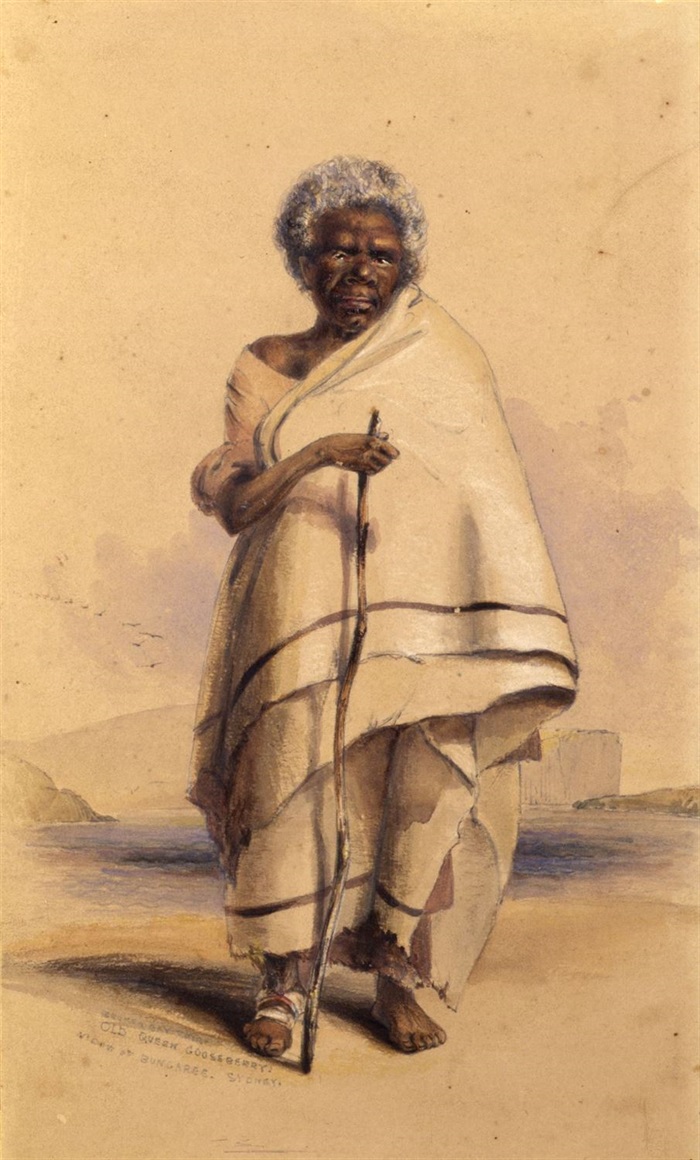
G F Angas 1845 Old Queen Gooseberry widow of Bungaree, Sydney. Angas Collection, SA Museum AA8-4-2-4
Camp Cove c1845
After the smallpox epidemic of 1789 decimated the local Aboriginal population, the survivors regrouped into new bands. Cora was the leader of a group of about a dozen Aboriginal people who, as recorded in 1845, were living at Camp Cove, camping around the lagoon that existed behind the beach (since filled in and forming part of the Camp Cove Reserve, off Cove Street). A chief activity of their life at Camp Cove was fishing which was both a source of food and, when the catch was sold at the Sydney Markets, income. As well as the importance of fishing, historian and archaeologist Paul Irish1 notes that cultural affiliation was likely an important reason for the group choosing to live at Camp Cove. Cora herself had detailed cultural knowledge of the area. There is evidence that Camp Cove has had a long history of Aboriginal occupation2.
![[Sketch plan of Watsons Bay area] - Pacific St, Camp St, Cove St, Victoria St, Bay St, Government Rd, Marine Parade. SLNSW Z/SP/W5/2. FL9127178](/files/assets/public/v/1/library/plaques/cora-gooseberry/slnsw_fl9127178-extract.jpg?w=2502&h=1676)
[An early sketch plan of Watsons Bay area - Pacific St, Camp St, Cove St, Victoria St, Bay St, Government Rd, Marine Parade]. SLNSW FL9127178 Z/SP/W5/2. [Undated] showing an area of 'Swamp' [Lagoon] bounded by Cove, Pacific and Victoria Streets.3
Early European recordings of rock engravings around the Sydney region were reliant on Aboriginal knowledge. Cora Gooseberry was one such person with the necessary cultural knowledge to be able to provide this information. In 1845 the artist George French Angas along with police commissioner William Augustus Miles visited Cora at Camp Cove to ask her about the meaning of rock engravings around the harbour. Cora took the men on a tour of engravings at North Head pointing out that she had learned ‘about the sacred nature of these engravings from her father’4
The tactic of interacting with Europeans and attempting to do so on their own terms by providing cultural knowledge and engaging in commercial activities, was a means of enabling survival for Aboriginal people in the new environment created by Europeans. To this end Cora would have drawn upon her cultural knowledge, status as an Aboriginal leader and public popularity.
A note on the placement of the plaque and Camp Cove Reserve
The placement of Woollahra Council’s plaque commemorating Cora Gooseberry/Karoo is representative of her connection with the broader Camp Cove locality, rather than identifying a precise location of significance to her story.
In Karoo’s time, the waters of a lagoon covered the land where the plaque is now installed, its remnant banks traced by the alignments of Pacific, Victoria and Cliff Streets. The route of a former creek is approximated by the small reserve that runs to the beachfront from the intersection of Pacific and Victoria Streets.5
The bushland surrounding the lagoon sustained abundant wildlife which, coupled with the rich harbour fishing grounds that lay within easy reach, made Camp Cove attractive for Indigenous settlement, both in traditional and early Colonial times.
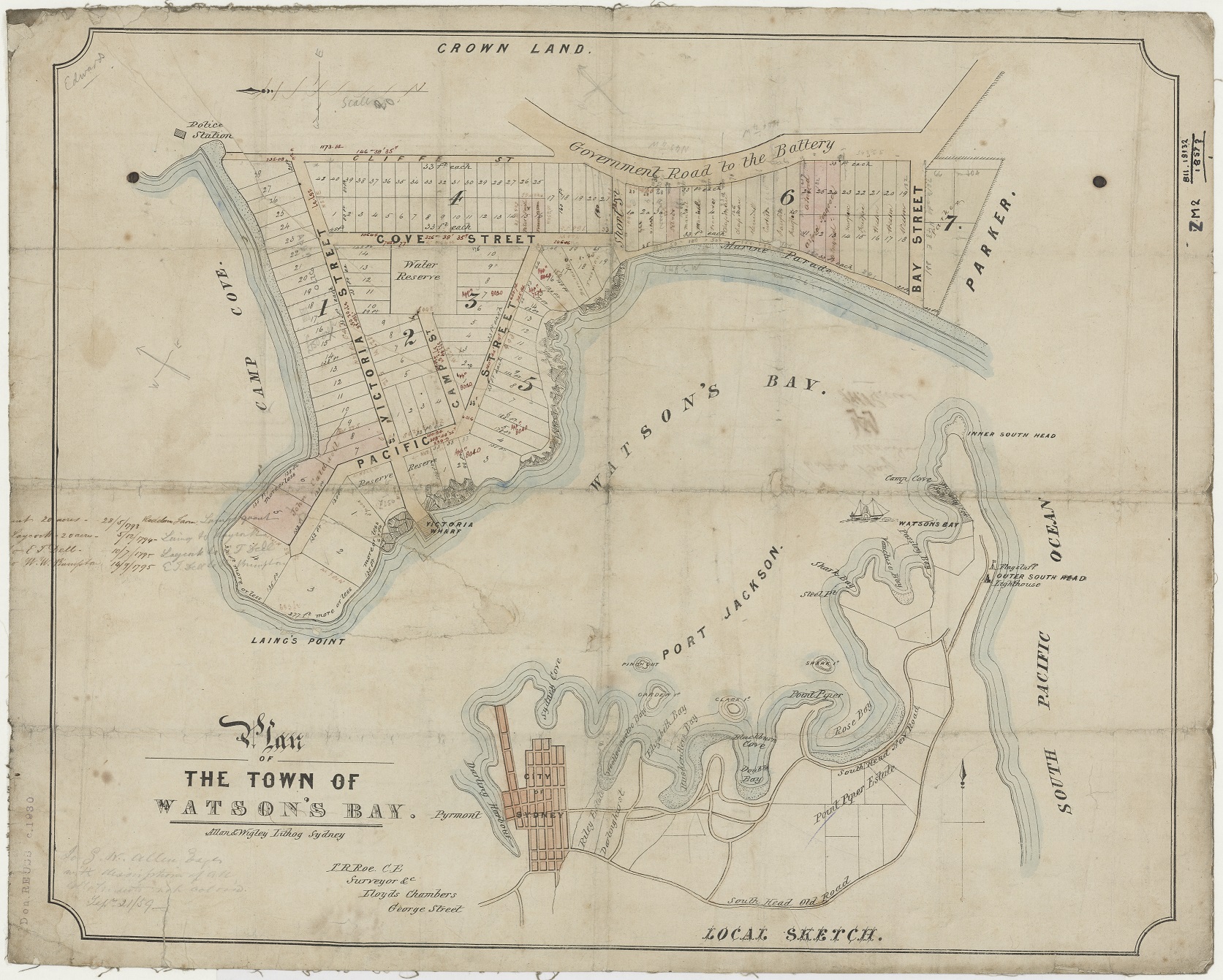
Plan of the town of Watsons Bay c1857 [showing the area marked as 'Water Reserve' on Cove Street] State Library of New South Wales FL3712591.
Although the land at Camp Cove was released by the Crown to surgeon Edward Laing in May 1793 – a 20 acre grant which Laing named Roddam Farm – it ‘passed through a number of non-resident owners from 1793 until 1843 before any attempt was made to subdivide the property’. ‘The 1841 census lists eleven households in the locality of Watsons Bay and South Head’, including the Water Police station, which had been established at the northern end of Camp Cove in 1840. (Martin, Meghan, 1997)
When the last decades of the 19th-century brought residential development to Camp Cove, the presence of a lagoon was at odds with the amenity of the neighbouring property. In early 1887, the colonial government resumed 2 roods, 20 perches of land at its centre - by then defined as a ‘water reserve’ - and dedicated it for public recreation.6 Camp Cove Reserve as we know it today came to fruition through various works undertaken over subsequent decades, the ground level raised in stages and effective drainage implemented.
Cora was recognised by Colonial authorities as a leader of the Aboriginal community who presented her with two engraved breastplates (gorgets), one identifying her as the 'Queen' of Sydney and Botany and the other as the Queen of Sydney to South Head. An initiative of Lachlan Macquarie, Bungaree, in 1815, was the first Aboriginal leader to have been presented with a breastplate which identified him as Chief of the Broken Bay Tribe.
![Cora Gooseberry, Freeman Bungaree, Queen of Sydney & Botany [Brass breastplate]. State Library of New South Wales Object Reference: 93QVAL41](/files/assets/public/v/1/library/plaques/cora-gooseberry/slnsw_fl3237014.jpg?w=1000&h=712)
Cora Gooseberry, Freeman Bungaree, Queen of Sydney & Botany [Brass breastplate]. Mitchell Library, State Library of New South Wales. FL3237020 7
The second gorget8, in the collections of the Australian Museum, is described as 'a crescent shaped, older style gorget decorated with a design of two fish either side of a central coronet, beneath which is the inscription ‘Gooseberry, Queen of Sydney to South Head’ and made of hand beaten brass.9
In 1846 Cora was living at the Domain with other Aboriginal people including her son-in-law Bowen Bungaree and her cousin and senior Aboriginal man, William Warrell. It was reported that during the day they wandered the city and often gave exhibitions of boomerang throwing at Hyde Park.10 In 1860, John Norton, a Lieutenant in the British Army 34th Regiment, wrote in his memoirs, that 'in the Autumn of 1815, being on military duty at Sidney [sic], New South Wales' he had received instruction in 'the art of throwing the Australian war-spear' from the wife of 'the native chief Bungaree': 'Her lithe ladyship ... when instructing me in the barrack square, at Sidney, threw a spear seven feet [about 2 metres] in length, to the distance of 120 yards'.11
Cora’s popularity and importance as a local Sydney identity and Aboriginal leader is evidenced in the numerous portraits made of her, including those by artists William Fernyhough (1836), Charles Rodius (1840’s), Eugene Delessert (with William Warrell, 1845) and George French Angas (1845).
For many years Cora maintained a friendship with Edward Borton, proprietor of the Cricketers Arms Hotel, corner of Market and Pitt Streets, a place she and William Warrell patronised. Borton allowed her to sleep in the kitchen of his residence at the Sydney Arms Hotel in Castlereagh Street. She was found dead ‘of natural causes’ at the Sydney Arms Hotel on 30 July 1852. Borton paid for her headstone and burial at the Devonshire Street Cemetery.
The Devonshire Cemetery was closed c1891, and to make way for the construction of the Central Railway Station c1900, the site was cleared with remains and headstones relocated to other cemeteries.12 Cora’s headstone was transferred to the Pioneer Memorial Park at Botany Cemetery (Eastern Suburbs Memorial Park).
Cora Gooseberry’s headstone was inscribed:
This STONE IS ERECTED BY MRS STEWART AND MR E. BORTON JUN IN MEMORY OF GOOSEBERRY QUEEN OF THE SYDNEY TRIBE OF ABORIGINES WHO DIED 30 JULY 1852 AGED 75 YEARS.
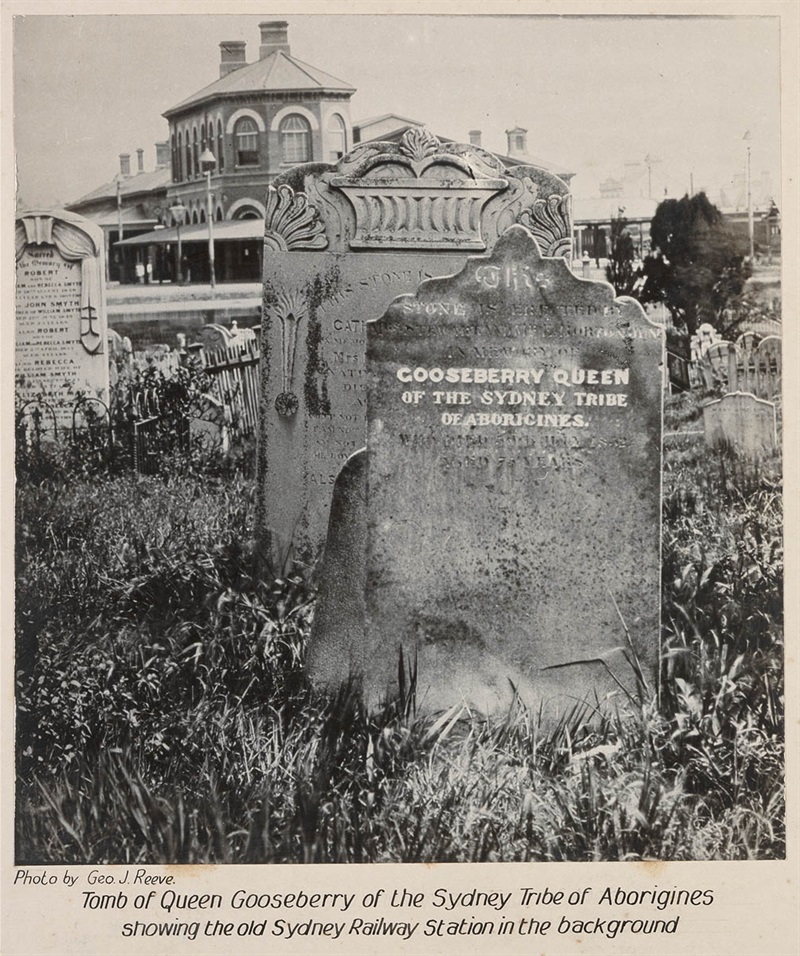
Headstone of Queen Gooseberry of the Sydney Tribe of Aborigines showing the old Sydney Railway Station in the background (Devonshire Street Cemetery) / Geo. J. Reeve. Royal Australian Historical Society. SLNSW FL3190237
In 2023, the life of Cora Gooseberry in colonial Sydney was explored and honoured in an exhibition at The Rocks Discovery Museum in Sydney13.
Cora lived during a pivotal part of Australia’s colonial history, and her grit and determination have provided strength and ambition to Indigenous women around the nation. 'The life of Cora Gooseberry' Rocks Discovery Museum, 2023.
Cora's husband Bungaree is recognised in Woollahra with a reserve and plaque on New South Head Road, Rose Bay. The plaque was the initiative of the Woollahra History and Heritage Society14. In 2022, a plaque commemorating Cora's cousin William Warrell, was installed on the Rose Bay Promenade under the Woollahra Council Plaque Scheme.15
Australian Dictionary of Biography https://adb.anu.edu.au/biography/gooseberry-cora-12942
Dictionary of Sydney
Irish, Paul, Hidden in plain view, New South Publishing, 2017
Irish, Paul, Coast History & Heritage, Woollahra LGA Aboriginal Heritage Study, 2021
Martin, Meghan, A Thematic History of Watsons Bay, Woollahra Council 1997
Smith, Keith, King Bungaree, Kangaroo Press, 1992
TROVE (Newspaper articles)
Woollahra Library Local History collections
Footnotes
1 Irish, Paul,Hidden in plain view, New South Publishing, 2017, p.37.
2 Irish, Paul,Coast History & Heritage, Woollahra LGA Aboriginal Heritage Study,2021, p.55 and Irish, 2017, p.37
3 Z/SP/W5/2 Mitchell Library, see: https://collection.sl.nsw.gov.au/record/74Vvqd63LaPd/BDEpVOLzZQzv6 See also fig.2.3 Irish, 2017.
4 Irish 2021, p.76 and Irish 2017, p.38
5 The presence of freshwater swamp/lagoon areas behind Camp Cove was reported by various sources. An 1843 advertisement for the subdivision of land near [Camp] Cove describes 'a rich swampy spot, in the centre of which, for general use, a circular spot is kept back as a reservoir' (Sydney Morning Herald 23.2.1843 p 4 http://nla.gov.au/nla.news-article12417624); G F Angas described 'a fresh-water lake close to Camp Cove' in 'Savage life and scenes in Australia and New Zealand, Smith Elder, London, 1847, vol 2, p 202. The site of the Biological Station at Camp Cove was described as having 'large fresh- water swamps and lagoons in the immediate neighbourhood' (SCIENCE (1881, May 14). The Sydney Mail and New South Wales Advertiser p. 779. http://nla.gov.au/nla.news-article161884761)
6 "Notification of Resumption of Land under 44 Victoria No. 16." New South Wales Government Gazette 18 January 1887 p. 371; "Government Gazette Proclamations and Legislation" New South Wales Government Gazette 29 March 1887 p. 2244.
7 Cora Gooseberry, Freeman Bungaree, Queen of Sydney & Botany [Brass breastplate]. Mitchell Library, State Library of New South Wales. FL3237020. https://collection.sl.nsw.gov.au/record/93QVAL41
8 An image of the breastplate is included in the following article: FD McCarthy, ‘Breast-plates: the Blackfellows’ Reward’, The Australian Museum Magazine, 1952, vol. 10, p. 328
9 See also: 'King Bungaree and Queen Gooseberry' at https://www.nma.gov.au/explore/features/aboriginal-breastplates/bungaree-gooseberry and 'Garrigarrang: Sea Country - Revealing stories of Indigenous Coastal Communities' [2014] athttps://australian.museum/about/organisation/media-centre/garrigarrang-sea-country/
10 Irish, 2017, p.48
11 Smith, Keith Vincent 'Cora Gooseberry: Spears & Bullets', 2019 at https://www.eorapeople.com.au/uncategorized/cora-gooseberry-spears-bullets/
12 'Central Railway Station : through the lens'. Museums of History New South Wales at https://mhnsw.au/stories/general/central-railway-station/
13 Saunders. Aiesha ,'The life of Cora Gooseberry' , Rocks Discovery Museum [2023] at https://rocksdiscoverymuseum.com/stories/cora-gooseberry
14 See: https://lhc.woollahra.nsw.gov.au/collections/?record=ecatalogue.200 and https://lhc.woollahra.nsw.gov.au/collections/?record=ecatalogue.1873
15 For more information on William Warrell the plaque see:https://www.woollahra.nsw.gov.au/library/local_history/woollahra_plaque_scheme/plaques/william-warrell
New plaques are added based on nominations from the community, which are then assessed against selection criteria and researched by a Local History Librarian.
Find out more and nominate a person or event for a plaque.